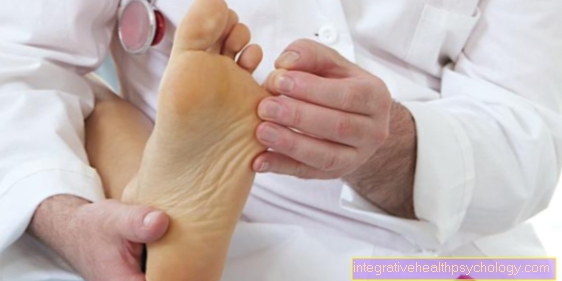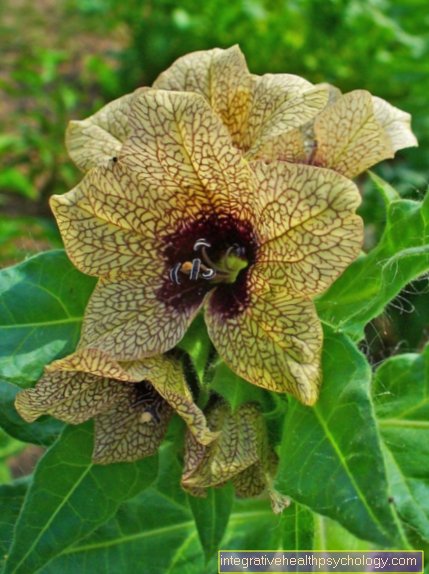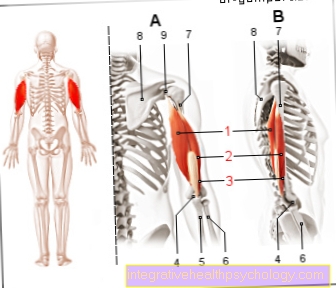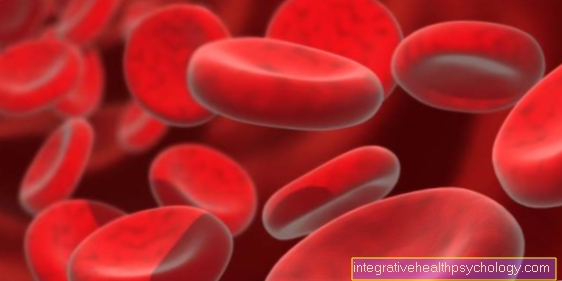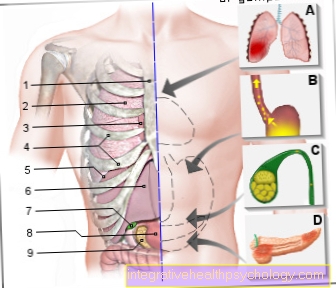Laceration on the head
definition
A laceration occurs on parts of the body where there is hardly any subcutaneous fatty tissue and the skin lies directly on the bones. The head, knee and shins are often affected.
The laceration is also called a tear-crush wound, this describes the development of the wound quite well. A blunt trauma (fall, blow) presses the skin onto the bone and tears or bursts.
Here you can find more general information on the topic: Laceration

Causes of a laceration on the head
Lacerations are caused by blunt force on the head. Often this happens by falling on hard ground or by striking with a solid object (e.g. hammer, rod, fist ...).
Children in particular get lacerations when learning new motor skills, young adults from high-spirited behavior or fights and older people from falls.
This article might also interest you: Lacerated wound
diagnosis
The diagnosis is made by inspecting the edges of the wound.
In the case of cuts, the wound edges are smooth and lie on top of one another (adapted).
It is different with lacerations. As the name suggests, the skin is split open at this point. The wound edges gape apart and are unevenly limited. Because the wound edges are standing apart, there is increased bleeding and it takes longer for a crust to form. Therefore, a laceration should be surgically stitched.
Accompanying symptoms of a laceration on the head
Lacerations usually bleed profusely. But it often looks worse than it is. It looks very dangerous, especially when blood spreads in light hair. However, since mostly only superficial small vessels are torn, the bleeding can be stopped quickly.
Local pains continue to develop, initially stabbing, later dull pulsing. The tissue around the wound swells and a bump develops that causes even more pain, especially when touched. Depending on how severe the trauma was, it can lead to mild to severe general headaches.
If the person concerned also complains of nausea, a traumatic brain injury (TBI) may have occurred. A doctor should be consulted.
Nausea, blurred vision, or brief loss of consciousness may indicate additional cerebral haemorrhage. Here, too, a hospital must be visited as soon as possible. Cerebral haemorrhage can be diagnosed with the help of a skull CT.
Read more on the topic: traumatic brain injury
Treatment / therapy
As an emergency measure, pressure should be applied to the wound immediately to stop the bleeding. This is best done with a sterile compress and wrapped a bandage tightly around your head. The wound should not be cleaned by yourself or treated with ointments.
A doctor - preferably a surgeon - should be consulted next. The bandage remains in place until a traumatic brain injury or cerebral hemorrhage is ruled out. The attending physician will always ask about the tetanus protection and, if necessary, refresh the vaccination.
A local anesthetic is then injected around the wound and wait until the area becomes numb. Then the wound is cleaned and disinfected. Next, the wound is sutured or stapled under sterile conditions so that the wound edges are brought together. At the end a bandage / plaster is applied. This association must be changed regularly.
Until the wound has healed, the wound should not get wet, it must be kept clean and regularly disinfected. Pain relievers such as ibuprofen can also be taken. At the same time, the wound should be moderately cooled. In general, those affected should take it easy.
Learn more: First aid for wounds
sew
The wound edges can be brought together with the help of sutures. Depending on the size of the wound, several sutures may be necessary. There are different types of suturing techniques. Single button sutures or an intracutaneous suture are mostly used for superficial wounds. The threads are usually left for 10-12 days, after which they are removed again.
Before sewing, the wound is disinfected and injected with local anesthetic so that the sewing process is not painful. An aesthetic result is particularly important on the hairless scalp, such as the forehead or face. The intracutaneous suture is the best choice here.
You can find more information on this topic here: Skin seam
Stapling
Another way to close a wound is by stapling. The edges of the wound are brought together and the site is fixed with a small metal clamp. This is usually only done on large, deeper wounds.
In any case, more subcutaneous fatty tissue must be available so that the clamps hold securely. The use of staples on the head is rather unsuitable. Here the skin is too thin and too tense. In addition, this results in a less attractive visual result.
Healing time
If the wound edges are well adapted (joined), the wound is well cared for, kept clean and dry and infection is prevented, wound healing takes 10-14 days. Then the threads can be pulled. The skin is then stable again and can be stressed.
However, if the wound is not well cared for, heavily stressed and inflammation occurs, wound healing can be delayed for some time and take several weeks.
It is therefore important to ensure that the wound is treated gently until the threads are removed.
The bandage / plaster should be changed every 2 days and the wound carefully cleaned with clear water or disinfectant and then carefully patted dry. For larger wounds, this should be done by a doctor.
Which laceration on the head do I have to see a doctor?
Any laceration on the head should be examined by a doctor. For a beautiful cosmetic result, a laceration must always be sewn or covered with adhesive plaster. For optimal wound healing, the wound edges must be brought together (adapted) well; this is only possible with sutures, especially with larger wounds (> 2cm). If this does not happen, the wound may only heal with an unsightly scar.
Complications of a laceration on the head
As with any wound, infection can occur. This manifests itself first as redness, swelling, overheating and pain around the wound edges.
The symptoms spread around the wound and can result in general symptoms such as fever and chills. In the worst case scenario, blood poisoning can occur. The skin on the head is well supplied with blood and large bruises can occur.
If the wound is not carefully cared for, unsightly scars can occur. The damage to fine nerves under the skin can lead to permanent sensory disturbances. Depending on how strong the blow was, accompanying bone fractures or internal bleeding (cerebral haemorrhage) may occur.
Scar after a laceration on the head
If the laceration is not sewn carefully and the wound edges are not well adapted, unsightly scars can occur. Even after the wound has healed, the area should not be exposed to the blazing sun and should be regularly creamed with nourishing ointments (e.g. Bepanthen).
Learn more: Scar care
Is it allowed to wash hair with a laceration on the head?
The wound should always be kept dry and clean. Until the wound has healed completely, the hair should only be washed with clear water if necessary and then dabbed dry. Soaps and shampoos should only be reused after the thread has been pulled.
Length of sick leave
The duration of the sick leave depends on the accompanying symptoms. As soon as the wound has been sutured, the bleeding has stopped and the headache has subsided, the person concerned can go back to work.
This is usually the case after 3-4 days. If nausea, dizziness or visual disturbances occur, or if the headache persists, the sick leave must be extended.
In the event of a traumatic brain injury or a cerebral hemorrhage, recovery can take several weeks.

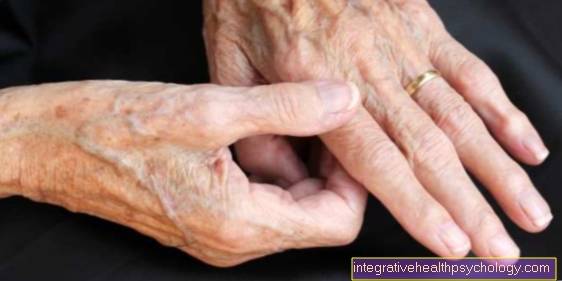


.jpg)


